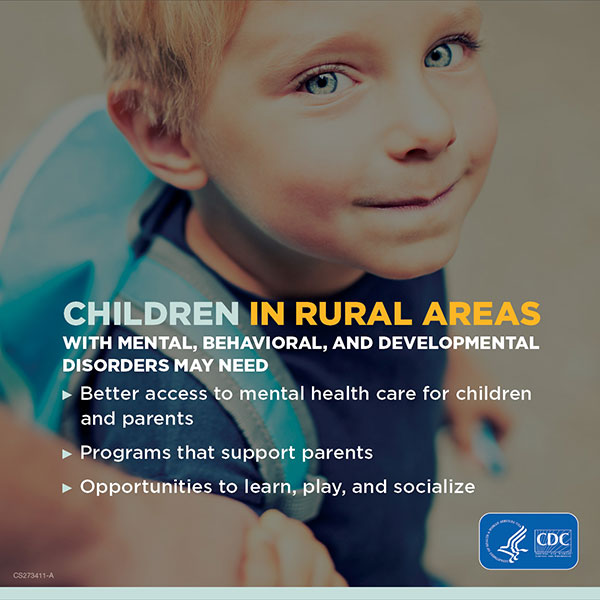Parental Stress and Childs Socioemotional Development Among Families in Rural Counties Vs Urban

When children grow up in a safety and nurturing home surround, accept opportunities to larn, and time to collaborate and build relationships with other children, they are more than likely to reach their full potential. This is specially true for children with mental, behavioral, and developmental disorders.
Mental, behavioral, and developmental disorders, such as anxiety, attention-deficit/hyperactivity disorder or ADHD, and learning problems, often begin in early babyhood and can bear on life-long wellness and well-being. Children with these disorders face up challenges at dwelling house, at school, and with friends. About ane in vii U.S. children aged two-eight years have a mental, behavioral, and/or developmental disorder reported by a parent.
Previous enquiry has shown that children with mental, behavioral, and developmental disorders and their families confront personal, financial, and neighborhood challenges more oft than families of children without these disorders. These challenges may make it harder for some parents to give their child the resource they demand to thrive. The blazon of community that families live in, urban versus rural, may increase these challenges.
To better understand the differences between urban and rural areas, Centers for Disease Control and Prevention (CDC) researchers collected information from parents on children's mental health in both urban and rural areas. Parents were asked questions about their child's mental wellness, their ain mental health, their neighborhood, and other personal and community factors.
Parents of children with mental, behavioral, and developmental disorders in rural areas (isolated, small rural, and large rural areas combined) more often reported having trouble getting by on their family's income than parents of children with these disorders in urban areas. Regardless of poverty level and race/ethnicity, these parents more ofttimes rated their ain mental health or their partner's mental health as "fair" or "poor;" they likewise more often reported living in a neighborhood in poor condition and without amenities, such as parks, recreation centers, and libraries. To overcome these challenges, children and their parents living in rural communities may need additional support.
Children with mental, behavioral, and developmental disorders can benefit from amend access to mental and behavioral health intendance, programs that back up parents and caregivers, and opportunities to learn, play, and socialize.i,2,3
Policy Brief: Access to Mental Health Services for Children in Rural Areas
What might assistance families and their children?
States that
- Support the delivery of affordable mental and behavioral wellness care to families.
- Foster policies and programs to alleviate financial hardships for families.
- Expand neighborhood amenities where they are lacking to allow children to play, read, and socialize.
Healthcare systems that
- Interact with early learning programs, parenting and caregiver support programs, and main care clinicians to assist meliorate access to mental and behavioral health care, and customs social and recreational resources.
- Explore ways to deliver affordable mental and behavioral wellness care services for parents and children, such as integrating these services into master care settings and schools, as well as using telehealth engineeringexternal icon.
Chief care clinicians that
- Connect families with mental and behavioral health care, parenting and caregiver support programs, and early learning programs.
- Screen parents for stress, depression, and other mental health problems to assistance connect parents to the right resource.
What is CDC doing?
CDC's National Eye on Birth Defects and Developmental Disabilities (NCBDDD) is committed to helping children with mental, behavioral, and developmental disorders and their families get the support they need. NCBDDD studies mental health and developmental disabilities, identifies factors that put children at chance for these conditions, and informs land and local determination-makers and other stakeholders, so that children and families can become the support they demand as early on as possible.
- CDC Morbidity and Mortality Weekly Written report (MMWR) rural health special issue, "Differences in Health Care, Family, and Customs Factors Associated with Mental, Behavioral, and Developmental Disorders amongst Children Aged ii-8 Years in Rural and Urban Areas – The states, 2011-2012".
- New England Periodical of Medicine commentaryexternal icon authored by Drs. Kelly Kelleher and William Gardner that highlights systems solutions that address disparities in access to mental health handling.
- Report published past the Milbank Memorial Fundexternal icon by Elizabeth Tobin Tyler, JD, MA and colleagues that describes bear witness-based strategies to better connect behavioral wellness professionals with principal care practitioners through behavioral health integration.
- A study looking at family, community and healthcare factors related to mental, behavioral, and developmental disorders amidst children aged 2 to 8 years was published in a contempo MMWR equally "Health Care, Family, and Community Factors Associated with Mental, Behavioral, and Developmental Disorders in Early Childhood — United states, 2011–2012".
- OtherMMWRs in the Rural Health Series.
- CDC's Children's Mental Health website
- CDC'south Kid Development website
- CDC'due south Birth Defects and Developmental Disorders website
References
- National Academies of Sciences Engineering and Medicine. (2016). Parenting Matters: Supporting Parents of Children Ages 0-8. Washington, DC: The National Academic Printing.
- National Research Council and Institute of Medicine. (2009). Preventing Mental, Emotional, and Behavioral Disorders Amid Young People: Progress and Possibilities. (K. E. O'Connell, T. Boat, & K. East. Warner Eds.). Washington, DC: The National Academic Press.
- U.S. Department of Health and Human Services, U.s. Department of Teaching, United states of america Department of Justice. (2000). Study of the Surgeon General's Conference on Children's Mental Health: A National Activeness Agenda. Washington, DC: Department of Health and Human Services.
Source: https://www.cdc.gov/childrensmentalhealth/features/rural-health.html
0 Response to "Parental Stress and Childs Socioemotional Development Among Families in Rural Counties Vs Urban"
Post a Comment